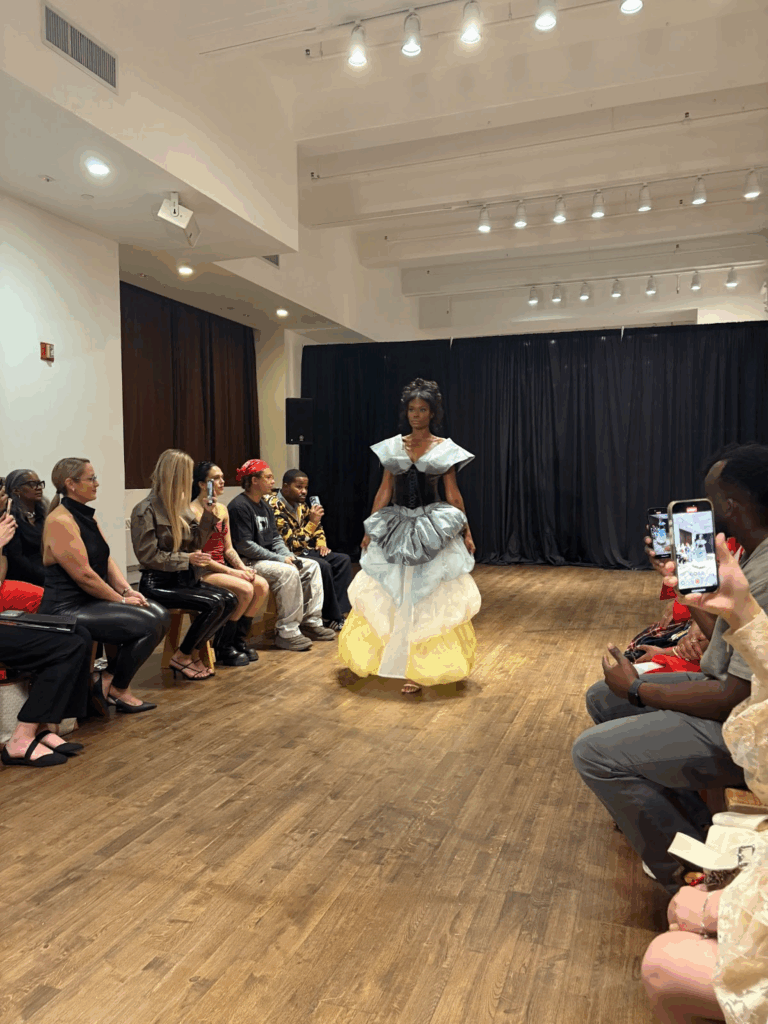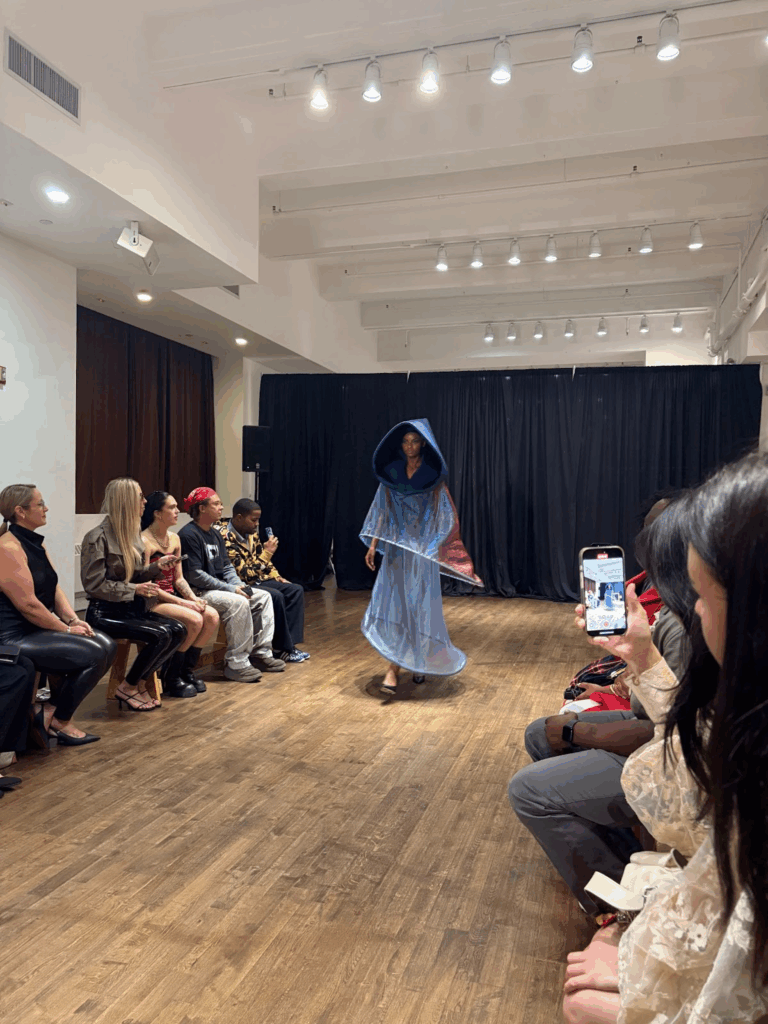“New York Fashion Week.” Try and sound it out — there’s a little catch that happens right between the end of “York” and the beginning of “Fashion.” It’s because of the quick jump we need to make from the back-of-the-throat sound at “k” to the curl of the lips at “f.” That phonetic leap is what gives the phrase rhythm.
And, in a way, the fashion industry is in the middle of its own leap — a leap from the runway to the algorithm, from a designer’s traditional grueling path towards success to the possibility of overnight social media stardom. At this year’s New York Fashion Week, I interviewed models, designers and stylists about how social media is reshaping the New York Fashion Week scene and the fashion world.
I arrived at 77 Walker St. about an hour before Planet Fashion TV’s show was slated to start. Models strutted in and out of the Walker Hotel Tribeca, rollers still clipped in their hair, a cigarette loosely hanging from one hand, a black coffee in the other. Feeling exposed under their smoky-eyeshadow gaze, I tried to find a less intimidating person of whom to ask some questions and made eye contact with a man holding a camera.
“Excuse me, sir, are you a photographer?”
“No, I just carry this camera for fun,” he deadpanned. I’ve inconvenienced someone, I thought — time to die. Andrew, whose name I would later learn, was just kidding. Seeing my despair at the thought of annoying him, he took pity and offered to introduce me to some designers — “if that’s something you’re interested in.”


Andrew led me through the venue, down an alley beside the Walker Hotel, and into a not-so-friendly-looking basement called the “pit.” There I met Adrianna Aloni, a 17-year-old designer showcasing her brand Josephine’s Closet for the seventh time at NYFW.
Clad in one of her own pieces, she looked every bit ready to walk in her own show but warmly accepted my request for an interview. When I asked what Fashion Week meant to her, she spoke with the kind of perspective that comes from years of growing up in the fashion world.
“I’ve been in the modeling and acting industry since I was three, and I’ve been designing since I was ten,” she said. That early start led to her first line debuting at NYFW when she was only 11. Since then, her work has focused on storytelling through inclusivity and comfort, a mission she describes simply: “I wanted to create a safe space for everyone to feel comfortable in their own skin and embrace their stories.”
Over the years, her collections have reached fashion capitals like New York, Milan, Paris and her hometown of Miami, yet her dedication to empowerment has remained constant.
“I’ve been doing this for 12 years now; my motive is just to make an impact on people.” With 58,000 followers on Instagram, Adrianna has watched social media reshape the industry. “It brings a lot of positive energy,” she noted, “but there is a downside to it.” She emphasized that the platform allows designers and models to be more creative and experimental than ever: “I wish social media didn’t have negativity, but we just have to look past it and do what we’re comfortable with. It’s all about being comfortable, because nobody else is living your life.”
After my interview with Adrianna, I ran into Marc Harvey, an artistic director and beauty entrepreneur, who has spent 20 years navigating fashion and beauty. After a quick chat with Andrew — who, as it turned out, had already spoken to Marc about me before I ran into him — I found a cozy spot with Marc in the middle of the Walker Hotel’s cafe and got to chatting.
Originally studying art and music, Marc found his home in the immersive nature of the fashion and beauty industries. “I loved everything art, so I had to hone into what I really liked, and I found I loved being an artistic director.” From glamming up models for runways to launching his own skincare and makeup brands, Marc has, as he says, “put in the work” to develop his artistic eye. “If you didn’t have the it-factor when you sat in my chair, you left with it!”
On the rise of social media, Marc notes both its benefits and drawbacks. Platforms allow designers and artists to gain instant visibility and be more creative, but they’ve also “watered down” the industry, making it harder to distinguish true talent. “It’s made things more accessible,” he says, “but if you don’t do the work — understand history, art history, the references — you’ll struggle to make an impact.” His advice for young creatives is clear: pursue your passions passionately, and put in your dues.


At my last stop of the day, which combined fashion collective Vitruvius’ NYFW presentation with designer Negris Labrum’s showcase, I also met Tim Victor, a Brooklyn-based stylist and model. I got tickets to two shows through MAISON at Yale, a student fashion group where I serve as a co–social chair; Vitruvius provided the tickets after sponsoring Maison’s spring show.
For Tim, Fashion Week is more than just glamour; it’s spiritual. “Style is about how you feel, and how you want other people to feel when you show up.” Fashion Week, he says, “is a time for us to really tap into ourselves and express what we’re processing through clothes.”
That self-awareness, he explained, is what makes someone’s style authentic. “A lot of us walk around pretending to be something we’re not. But what you think is wrong with you is actually what’s right about you, because that’s your power.” When our conversation turned to social media, Victor was clear-eyed about its role: “It’s good, but at the same time, I have to take breaks. It starts to become performative, and when it gets to that place, it’s not authentic.”
But for him, the internet has also blown open the gates of fashion. “Before, there was always one way in. You had to know someone, or go through an agency, or already have the money. Now? All you need is your phone. Pay your bill, post every day, and if it’s real, if it’s authentic, people will feel that.


And when the lights began to dim and the chatter of the attendees thinned to a murmur, I knew that the show was about to begin. I thanked Tim, told him not to forget me when Law Roach called him up and returned to my seat for the show to begin.
An AI show.
Vitruvius’ NYFW show was themed AI x Fashion, with AI tools being used throughout the designing process. The theme, as I would later learn from Vitruvius’ founder Wayne Chiang, was meant to encourage designers to explore how artificial intelligence is reshaping the fashion industry, not just as a tool, but as a creative collaborator. Now, to be completely clear, Vitruvius’ aim was not for designers to rely on artificial intelligence when designing pieces, but to integrate technology meaningfully into the designers’ fashion.
It was certainly shocking, to say the least, to see designers openly use artificial intelligence in the designing process at a time when AI use is immensely controversial in creative fields. When I asked Wayne about this, he said, “For us, it’s just a step. Where a part of the process may have taken ten minutes, it now just takes three seconds. AI gets things wrong, and the designers work to fix them.”


I came back from New York at 1:00 a.m., my feet sore from the heeled boots I thought were a good idea and my mind still buzzing with the day’s excitement. “New York Fashion Week,” I whispered to myself in bed, before my roommate stirred and I worried I’d woken her.
Before that day, my closest interaction with any fashion week had been through The Devil Wears Prada. I first watched it when I was 15, scoffing at Andy Sachs’ too-cool-for-fashion attitude and falling in love with her outfits. Since then, I’d longed to be part of the industry I had romanticized through 2000s movies and TV shows. But the fashion world I thought I knew — the one Miranda Priestly ruled with an iron fist, the one that made and crushed designers’ careers through a brutal climb — is changing.
Today, social media and AI are rewriting the rules and shaping trends. New York Fashion Week is not just about the shows; it’s a stage for experimentation and a mirror of technological and social progress. With AI still heavily criticized in the art world, it’s unclear where the creative minds that shape the industry will approach its use. Will it be embraced and openly used, like in Guess’ advertisement featuring an AI model in Vogue’s August 2025 print edition, or will it be shunned and disregarded by artists? One thing is clear: Designers, audiences, and technology are evolving together, and fashion itself has never moved faster.


